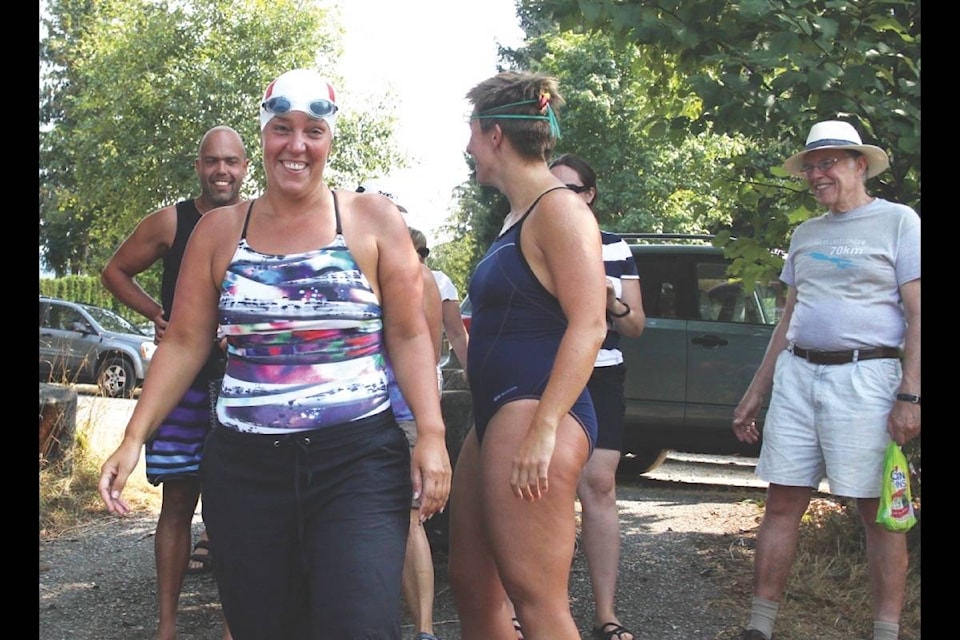The outstanding feat of swimming Juan de Fuca Strait by paralympic swimmers Jill Yoneda and Susan Simmons was first attempted in 1954.
Although marine experts were dubious that “world-famous mermaid” Florence Chadwick could defeat notorious Juan de Fuca Strait, civic leaders hailed the venture, launched by a Victoria newspaper publisher and a paint company and carried around the world by wire service, as “the greatest publicity scheme ever seen here”.
Hydrographic surveys officials gave their assurance that summer temperatures definitely would be eight degrees warmer than in winter — perhaps as ‘warm’ as 52 degrees F (11 C).
From her home in California, Miss Chadwick studied the conditions she could expect to encounter. She explained it was “like planning a military invasion. You have to study the beaches, lunar and tide tables to pick the very best time for your assault.
“Naturally, you want smooth seas. An error in calculations may mean the difference between success and failure. From all I’ve learned about the Straits [sic], the tides are rather severe. That’s something I will have to study closely.”
Upon her arrival, Jan. 21, 1954, the smiling, five-foot-six, 34-year-old champion in “poodle-cut” hairdo was met by a welcome committee of 200 and whisked to the Empress Hotel in the mayor’s car.
She stressed that it was all a matter of teamwork — “All I do is swim” — with her pilot, navigator and trainer, and her frayed bathrobe for a good luck charm. Her 138 pounds would be bulked up to 152 pounds by eating steaks and green vegetables to compensate for the six pounds she lost per marathon swim.
She practised seven hours a day, six days a week, for six months before each swim. For the actual test she coated herself in heavy grease, wore an old-fashioned bathing suite of black silk jersey, and munched on lump sugar (four lumps per hour) for energy, supplemented by beef broth and soft drinks.
After an inspection cruise aboard the tug Island Navigator, Miss Chadwick announced to a waiting city: “I’ve looked over the course and in my opinion the currents can be figured out so we can get through all right. It’s going to be a question of how much cold water I can take. I’m anxious to try it and I think I can make it.”
She’d astounded tug master Capt. Ellice Cavin with her statement she could swim a mile every 10 minutes for 16 hours. “Why, that’s better time than we make with a boom of logs!” he declared.
On July 1 she returned to Victoria with her mother. Next morning, as 1,000 residents watched, she experienced her first trial in the comparatively friendly waters of Cadboro Bay, where the water temperature dipped to 49 F.
Finally came the big day — Aug. 9, 1954 — after weeks of arduous training, of gaining weight, public appearances and planning. At 5 a.m., as a fleet of small craft including official parties, the press, the U.S. Coast Guard and spectators converged, she took to the frigid water “as though she were sprinting in a 100-yard race, her famous eight-beat crawl quickly [taking] her away from the beach”.
From the darkened shore came the strains of ‘For She’s A Jolly Good Fellow,’ sung by 5,000 well-wishers. Conditions were ideal: calm seas, no wind, the water 50 degrees F.
Steadily, she pulled away from shore, easily maintaining her planned 28 strokes to the minute. Archie McKinnon, Jack Todd and her brother Dick Chadwick kept abreast in a rowboat, the rest of the flotilla fanning out astern. Forty minutes out, she asked for an aspirin which was given with half a bottle of pop. By then the water temperature had fallen one degree.
Periodically, she paused to empty salt water from her goggles and to accept a drink, then resumed swimming within 45 seconds. After two hours, she’d reached the 3.5-mile mark in a slight chop. By 7:30 she was five miles out, veering slightly towards Race Rocks in a gentle southwesterly wind as the tug held a position ahead to serve as a wind-break.
9 a.m. Port Angeles was clearly visible.
9:50 a.m. After vomiting, she picked up her stroke. The weather was clearing and she expected to hit the flood tide shortly. Her goggles were leaking.
9:55 a.m. It was over! Unable to continue, she was pulled into the boat and bundled into a blanket. Pale and weak, she managed a smile as a helicopter television cameraman passed overhead.
After five hours, 11 minutes and 12 seconds in the frigid water, with her muscles stiffening, she’d struggled 11 miles. But the powerful currents had swept her in an arc, to within seven miles of her departure point in Beacon Hill Park.
A reporter noted that coach McKinnon seemed just short of tears, and a pervasive sense of gloom accompanied the fleet back to town. All, including those watching on TV, had been shocked by the sudden ending to the long-heralded contest. When she landed at the Bapco Paint wharf, thousands lined the streets to cheer her motorcade.
Florence Chadwick swam the English Channel four times, twice setting a speed record, Catalina Island to the California Coast and the Straits of Gibraltar. But she never attempted her avowed second tilt at Juan de Fuca Strait.
During the ‘Strait Fever’ that followed, Marilyn Bell, Cliff Lumsden and Bert Thomas did conquer this formidable, frigid sea. And, as of this week, Susan Simmons and Jill Yoneda.
